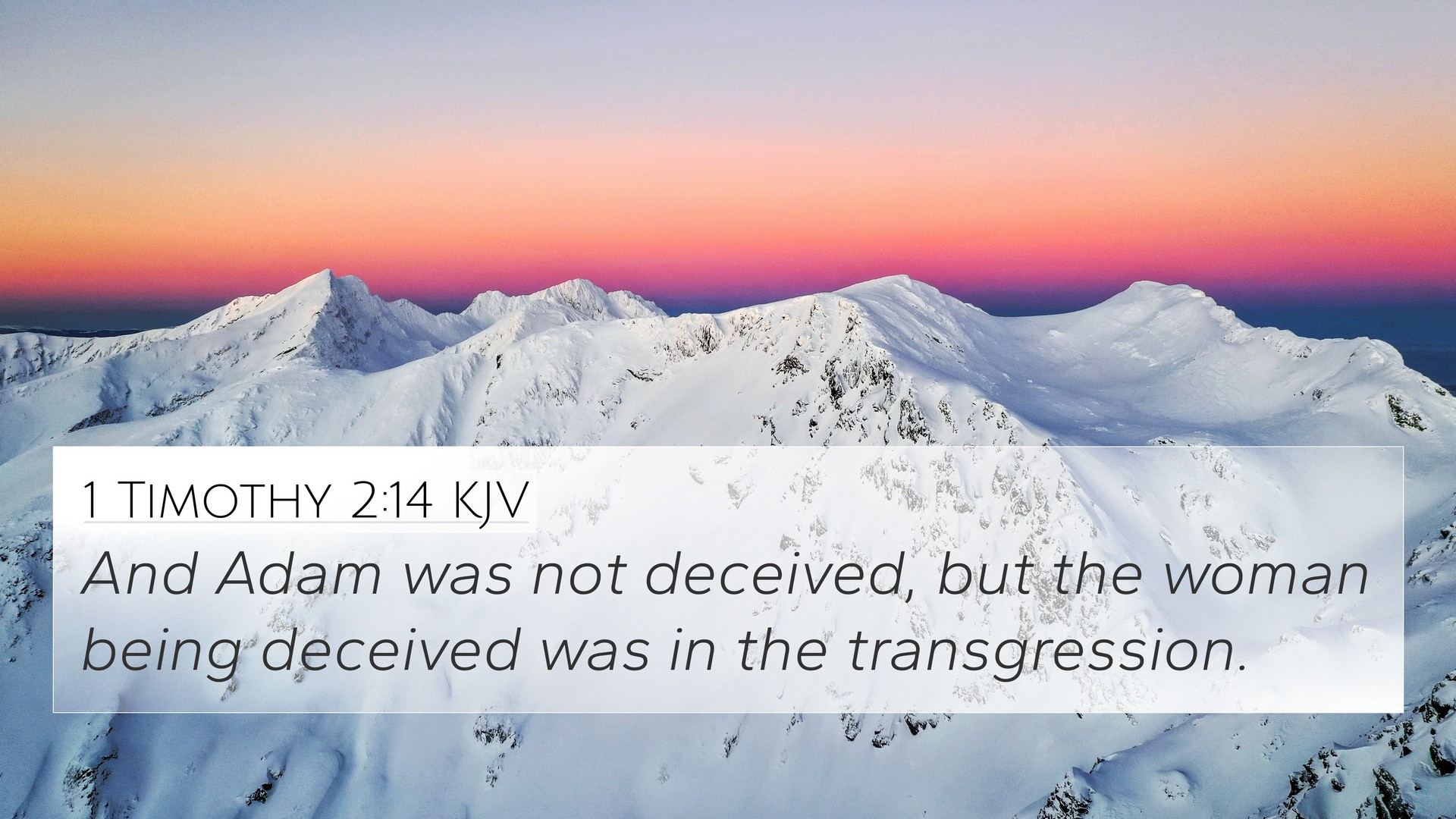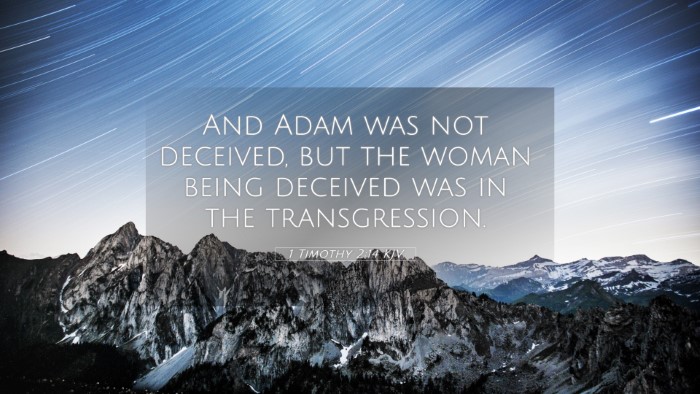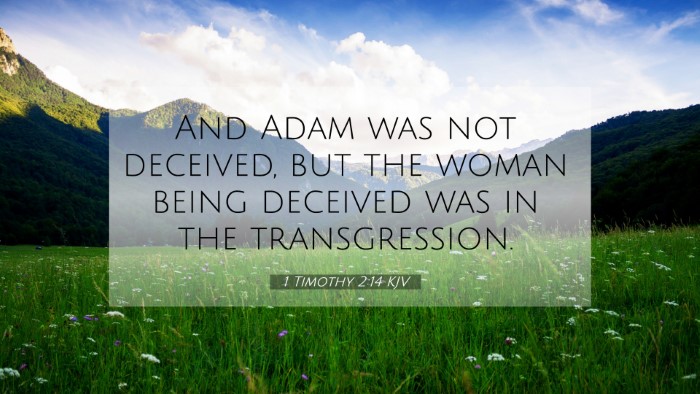Old Testament
Genesis Exodus Leviticus Numbers Deuteronomy Joshua Judges Ruth 1 Samuel 2 Samuel 1 Kings 2 Kings 1 Chronicles 2 Chronicles Ezra Nehemiah Esther Job Psalms Proverbs Ecclesiastes Song of Solomon Isaiah Jeremiah Lamentations Ezekiel Daniel Hosea Joel Amos Obadiah Jonah Micah Nahum Habakkuk Zephaniah Haggai Zechariah Malachi1 Timothy 2:14 Similar Verses
1 Timothy 2:14 Cross References
And Adam was not deceived, but the woman being deceived was in the transgression.
Uncover the Rich Themes and Topics of This Bible Verse
Listed below are the Bible themes associated with 1 Timothy 2:14. We invite you to explore each theme to gain deeper insights into the Scriptures.
1 Timothy 2:14 Cross Reference Verses
This section features a detailed cross-reference designed to enrich your understanding of the Scriptures. Below, you will find carefully selected verses that echo the themes and teachings related to 1 Timothy 2:14 KJV. Click on any image to explore detailed analyses of related Bible verses and uncover deeper theological insights.
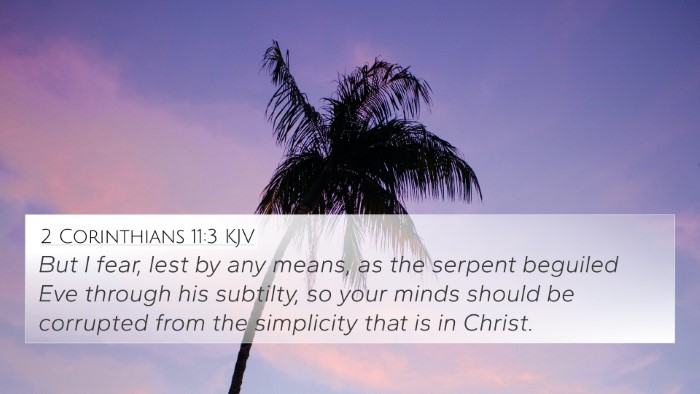
2 Corinthians 11:3 (KJV) »
But I fear, lest by any means, as the serpent beguiled Eve through his subtilty, so your minds should be corrupted from the simplicity that is in Christ.
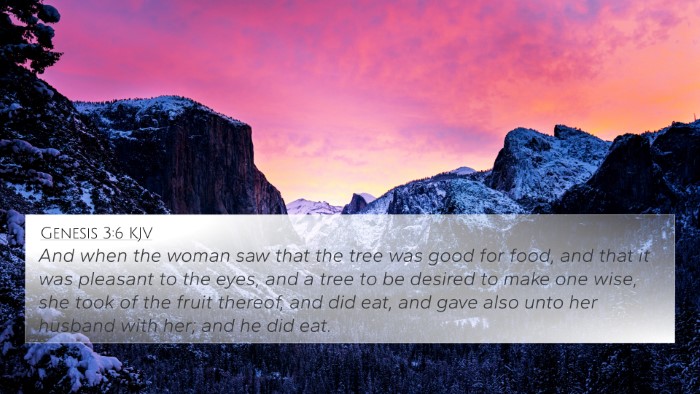
Genesis 3:6 (KJV) »
And when the woman saw that the tree was good for food, and that it was pleasant to the eyes, and a tree to be desired to make one wise, she took of the fruit thereof, and did eat, and gave also unto her husband with her; and he did eat.
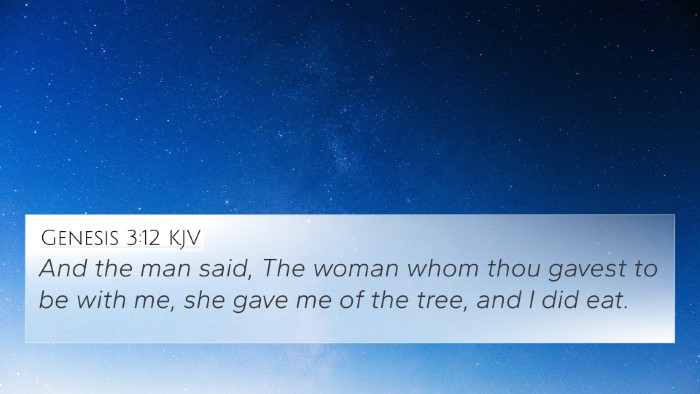
Genesis 3:12 (KJV) »
And the man said, The woman whom thou gavest to be with me, she gave me of the tree, and I did eat.
1 Timothy 2:14 Verse Analysis and Similar Verses
Meaning and Interpretation of 1 Timothy 2:14
"And Adam was not deceived, but the woman being deceived was in the transgression." - 1 Timothy 2:14
Summary
This verse emphasizes the roles and responsibilities of Adam and Eve in the context of the fall. It highlights that while both were responsible for their actions, the method of deception and the consequences that followed were notably different between the two. The Apostle Paul, through this verse, aims to convey a broader message regarding understanding authority and order within the church, making it pertinent for the discussion of gender roles in a religious setting.
Commentary Insights
Insights from several public domain commentaries provide a rich understanding of this verse:
- Matthew Henry: He reflects on the nature of temptation faced by Eve, explaining that the woman was more easily led into error due to her being deceived. Henry notes that this serves as an instructive example to women concerning their roles in the community of faith and the significance of discerning truth.
- Albert Barnes: Barnes points out that Paul’s assertion regarding Adam not being deceived underscores the responsibility placed on him for his actions. He draws a comparison between the two, emphasizing that Adam made a conscious choice to sin, whereas Eve was misled. This distinction is crucial in understanding the dynamics of sin and responsibility.
- Adam Clarke: Clarke elaborates on the implications of this passage for understanding womanhood and authority in the church. He suggests that this should not be seen as a statement of inferiority but as a contextual clarification of the order and roles established in creation, aimed at enhancing the functioning of the church.
Bible Verse Cross-References
1 Timothy 2:14 connects with several other verses that provide deeper insights into its message:
- Genesis 2:22-24: The creation of woman from man sets the groundwork for understanding their roles in creation.
- Genesis 3:6-13: The account of the fall, where Eve is deceived and Adam follows, parallels the implications noted in Timothy.
- 1 Corinthians 11:8-9: Paul discusses the order of creation, emphasizing man’s role in relation to woman.
- 2 Corinthians 11:3: Paul warns the Corinthians about being led astray, much like Eve, highlighting the significance of discernment.
- 1 Peter 3:7: Peter’s instructions on understanding and respecting the roles of men and women further tie into this theme.
- Galatians 3:28: While emphasizing equality in Christ, this verse creates a balance with understanding roles as noted in 1 Timothy.
- Ephesians 5:22-24: This passage also discusses the relationship between husbands and wives, reinforcing the hierarchical structure prescribed in Timothy.
Thematic Connections
This verse can be examined in relation to broader themes found throughout the Bible:
- The Fall and Redemption: Understanding the fall provides context for the need for redemption, which is a central theme in all scripture.
- Authority and Submission: The concept of authority and order is a recurring theme in both the Old and New Testaments.
- Discerning Truth: The necessity of discernment is vital for spiritual growth and strength in resisting temptation.
Cross-Referencing Tools
For those interested in deepening their study of 1 Timothy 2:14 and its surrounding themes, using various tools for Bible cross-referencing can be beneficial:
- Bible concordance to locate related verses.
- Bible cross-reference guide for thematic studies.
- Cross-reference Bible study methodologies for comprehensive analysis.
- Identifying connections between Old and New Testament teachings.
Conclusion
1 Timothy 2:14 offers profound insights into the dynamics of temptation, sin, and the established order of creation as seen through the lens of Paul’s teachings. By examining this verse alongside its cross-references, believers can gain a comprehensive understanding of its implications for faith, church order, and personal conduct.
